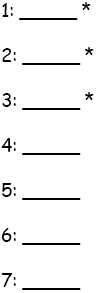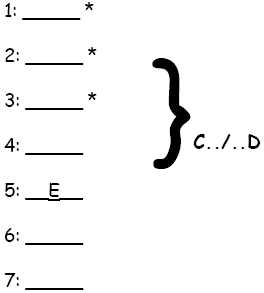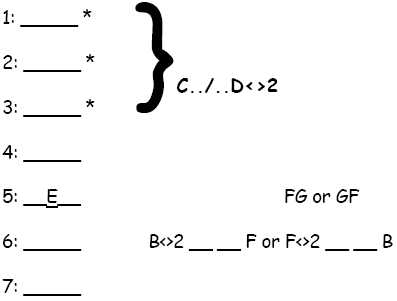LSAT Sequencing Games
Sequencing is the most common skill used on the Analytical Reasoning section of the LSAT. Fortunately, sequencing is something you do everyday.
This is the first of a series of articles about LSAT Sequencing Games. The series includes:
- LSAT Sequencing Games: an Introduction
- Sequencing Game Questions
- LSAT Practice Sequencing Game 1
- LSAT Practice Sequencing Game 2
- LSAT Practice Sequencing Game 3
LSAT Sequencing Games
Sequencing is the act of putting things in a specific sequence, or ordered list. When you write appointments on a calendar, you are sequencing. When your English professor ranks the students in her class by grade, she is sequencing. When you go to a restaurant and decide to start with hoisin kebabs, then have a mesclun salad followed by a wood-fired pizza, some ice cream, and finally a shot of espresso, you are sequencing.
Sequencing on the LSAT means easy points. On a typical exam you will have at least one sequencing puzzle, maybe two, and probably another hybrid puzzle that involves sequencing with some other skill. TestSherpa students who are good at sequencing can probably bank on at least half of the section without any worries.
Do sequencing games first. You sequence things everyday, you’re good at it. You can do it fast. That leaves you more time for the harder games. Remember to preview all the games to find the sequencing games–they won’t always be at the beginning of the section.
LSAT Sequencing Games Setups
Let’s take a look at some basic sequencing setups so that you’re familiar with typical sequencing games. Since sequencing gives you fast and easy points, you want to be able to recognize sequencing games right away and start with them.
Consider what makes the following three setups sequencing games, as opposed to grouping, matching, or hybrid games.
Alvin, Bea, Cathy, Dave, Ed, Flo, and Gary compete in a local swim meet. The swimmers placed according to their finishing times, from 1 being to fastest, to 7 being the slowest. The fastest three swimmers received medals.
How do you recognize this as a sequencing game? First, the LSAT likes to use topics like competitions, grades, and other objective comparisons for ranking games, which is a type of sequencing. Second, the phrase “The swimmers placed according to their finishing times,” tips you off that you’ll be asked to figure out that order, or sequence. This is a game of sequencing that will ask you to place the swimmers in the order they finished the race.
At a lumber warehouse, ten boards are marked Q, R, S, T, U, V, W, X, Y, and Z. The boards are to be sorted into various bins according to their height, from tallest to shortest. Each board is of a different height than the others.
Why is this a sequencing game? Doesn’t it seem more like a grouping game, since you will be placing the boards into bins? We know that the bins are in order of height, and that “each board is of a different height than the others.” The game is asking us to sequence the boards according to their height.
Now that we’ve identified two sequencing games, let’s take a look at the games in more detail.
LSAT Sequencing Games: Ranking
We’ve already seen that the first game is a sequencing game of ranking. Here is the entire question stimulus. Read it (step 1 of the TestSherpa method for games) and get a clear picture of the tasks involved.
Alvin, Bea, Cathy, Dave, Ed, Flo, and Gary compete in a local swim meet. The swimmers placed according to their finishing times, from 1 being to fastest, to 7 being the slowest. The fastest three swimmers received medals. We know the following about the finishing order of the swimmers:
Flo finished just before or after Gary
Cathy and Dave did not finish consecutively
Ed finished fifth
Two swimmers finished between Bea and Flo
Cathy received a medal
By analyzing the sequencing game setup, we can answer the following questions for ourselves:
- What entities are involved? Swimmers A though G.
- What situation are they in? They’re racing for the top three spots.
- What action are we supposed to do? Since it’s a race and we know something about the order they finish in, it’s a sequencing game, specifically ranking.
- Are there any limits or rules in the setup? The swimmers are ranked 1 to 7 and only three get medals.
What would the LSAT typically ask you about this type of sequencing game?
- Which swimmers finish first and last?
- In what order do the others finish?
- How can I make chains of finish times to deduce other finish times?
Make a Sketch
Almost all puzzles are easier to solve if you have a sketch to work with. A sketch is just a simple visualization of the situation. The simpler the sketch the better; however, be as detailed as you need to be to fit the rules in. Do not try to save time by throwing down a sloppy sketch. You’ll lose that time and more trying to make sense of the mess later. Think about a clear, clean, and simple diagram that summarizes the situation visually.
First, we know this is a ranking game, so we need to know the rank of the swimmers. Typically, you will draw ranking sequences from top to bottom. This is how you normally see ranking sequences in real life, such top ten lists. If you prefer, however, you could draw them left to right. Just make sure you are consistent in your practice, so that come test day, you know exactly what to do with your sketch.
So, to start with, you would probably draw seven simple lines, each line representing a different finishing rank for each swimmer. You might also indicate that the top three get a medal (put a start next to the top three).
Your sketch might look something like this:

You should get some scratch paper and actually make these sketches as we go along so you can get some practice and easily refer to them during this lesson.
Paraphrase the Rules
Next come a group of indented rules that govern the game. Your ability to paraphrase, understand, and manipulate the rules is the key to getting a high score on the Analytical Reasoning section. The questions in this section will test your ability to make deductions based on these rules.
Remember, there are really only three things you can do with a rule.
- Add it to your sketch.
- Paraphrase it next to your sketch.
- Circle and return to a tricky rule.
Also, remember that just because step 3 of the TestSherpa method is to paraphrase the rules, and step 4 is to make deductions, that doesn’t mean you shouldn’t make deductions at step 3 if they occur to you. Some deductions are obvious as you start putting the rules into your sketch. Don’t wait for step 4 or you might forget them. Step 4 is more about digging deeper to get the deductions you need for the test.
Some TestSherpa students like to take the rules in order. Others like to deal with the most concrete rules first. Do what is comfortable to you and make sure you consider all the rules. After you make your sketch and paraphrase of a rule, put a check mark next to it.
The most concrete rules are the third and last about Ed and Cathy. You could easily build those right into the sketch. Further, since Cathy is in the second rule two, you could combine rules two and five. Your sketch might look something like this:

The paraphrase “C../..D” means that Cathy and David are not next to each other. This is one possible way to indicate this rule, you might have other ways. It doesn’t matter how you write it as long as you know what you mean and you’re consistent in your practice so it comes as second nature on test day.
The two remaining rules could be paraphrased this way somewhere next to your sketch:
Flo finished just before or after Gary:
FG or GF
Two swimmers finished between Bea and Flo:
B _ _ F or F _ _ B
Make Deductions
You make deductions by combining rules. We already combined rules about Cathy and David, which tells us something more about David: he can’t come in second place. Cathy has to be 1, 2, or 3, so David could be 1 or 3 but never 2.
We also know that Bea and Flo could never be second by combining their rule with the Ed rule. For example, if Bea is in spot 2, Flo has to be three spots away (two swimmers between them). That would put Flo in spot five, but Ed is already there.
Now you’re sketch might look something like this:

Now that you’ve seen setups for LSAT Sequencing Games, let’s take a look at typical Sequencing Game Questions.
